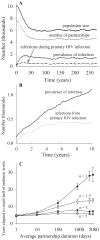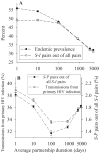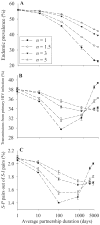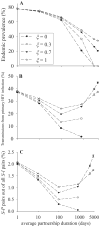HIV transmission by stage of infection and pattern of sexual partnerships
- PMID: 20571409
- PMCID: PMC3018805
- DOI: 10.1097/EDE.0b013e3181e6639f
HIV transmission by stage of infection and pattern of sexual partnerships
Abstract
Background: Most model analyses examining the role of primary HIV infection in the HIV epidemic ignore the fact that HIV is often transmitted through long-term, concurrent sexual partnerships. We sought to understand how duration and concurrency of sexual partnerships affect the role of transmissions during primary HIV infection.
Methods: We constructed a stochastic individual-based model of HIV transmission in a homogeneous population where partnerships form and dissolve. Using observed contagiousness by stage of HIV infection, the fraction of transmissions during primary HIV infection at equilibrium was examined across varying partnership durations and concurrencies.
Results: The fraction of transmissions during primary HIV infection has a U-shaped relationship with partnership duration. The fraction drops with increasing partnership duration for partnerships with shorter average duration but rises for partnerships with longer average duration. Partnership concurrency modifies this relationship. The fraction of transmissions during primary HIV infection increases with increasing partnership concurrency for partnerships with shorter average duration, but decreases for partnerships with longer average duration.
Conclusions: Partnership patterns strongly influence the transmission of HIV and do so differentially by stage of infection. Dynamic partnerships need to be taken into account to make a robust inference on the role of different stages of HIV infection.
Figures






Similar articles
-
HIV transmissions by stage in dynamic sexual partnerships.J Theor Biol. 2012 Apr 7;298:147-53. doi: 10.1016/j.jtbi.2011.12.021. Epub 2012 Jan 12. J Theor Biol. 2012. PMID: 22261263 Free PMC article.
-
HIV transmissions by stage and sex role in long-term concurrent sexual partnerships.Acta Biotheor. 2015 Mar;63(1):33-54. doi: 10.1007/s10441-014-9242-8. Epub 2014 Oct 24. Acta Biotheor. 2015. PMID: 25342082
-
Sexual partnership patterns in malawi: implications for HIV/STI transmission.Sex Transm Dis. 2011 Jul;38(7):657-66. doi: 10.1097/OLQ.0b013e31820cb223. Sex Transm Dis. 2011. PMID: 21301383 Free PMC article.
-
Concurrent sexual partnerships and the HIV epidemics in Africa: evidence to move forward.AIDS Behav. 2010 Feb;14(1):11-6; dicussion 34-7. doi: 10.1007/s10461-008-9433-x. Epub 2008 Jul 22. AIDS Behav. 2010. PMID: 18648926 Review.
-
AIDS in rural Africa: a paradigm for HIV-1 prevention.Int J STD AIDS. 1996 Jul;7(4):236-43. doi: 10.1258/0956462961917906. Int J STD AIDS. 1996. PMID: 8876353 Review.
Cited by
-
Incidence of HIV disclosure among HIV affected heterosexual partners using a community health worker led mechanism in rural Uganda; a quasi-experimental study.BMC Infect Dis. 2023 May 11;23(1):318. doi: 10.1186/s12879-023-08282-0. BMC Infect Dis. 2023. PMID: 37170206 Free PMC article.
-
Test-and-treat approach to HIV/AIDS: a primer for mathematical modeling.Theor Biol Med Model. 2017 Sep 5;14(1):16. doi: 10.1186/s12976-017-0062-9. Theor Biol Med Model. 2017. PMID: 28870213 Free PMC article. Review.
-
Agent based modelling of blood borne viruses: a scoping review.BMC Infect Dis. 2024 Dec 18;24(1):1411. doi: 10.1186/s12879-024-10271-w. BMC Infect Dis. 2024. PMID: 39695997 Free PMC article.
-
Detectable signals of episodic risk effects on acute HIV transmission: strategies for analyzing transmission systems using genetic data.Epidemics. 2013 Mar;5(1):44-55. doi: 10.1016/j.epidem.2012.11.003. Epub 2012 Nov 23. Epidemics. 2013. PMID: 23438430 Free PMC article.
-
Factors associated with men in HIV-negative gay couples who practiced UAI within and outside of their relationship.AIDS Behav. 2013 May;17(4):1329-37. doi: 10.1007/s10461-012-0255-5. AIDS Behav. 2013. PMID: 22790903 Free PMC article.
References
-
- Jacquez JA, Koopman JS, Simon CP, Longini IM., Jr Role of the primary infection in epidemics of HIV infection in gay cohorts. J Acquir Immune Defic Syndr. 1994;7:1169 –1184. - PubMed
-
- Koopman JS, Jacquez JA, Welch GW, et al. The role of early HIV infection in the spread of HIV through populations. J Acquir Immune Defic Syndr Hum Retrovirol. 1997;14:249 –258. - PubMed
-
- Rapatski BL, Suppe FP, Yorke JA. HIV epidemics driven by late disease stage transmission. J Acquir Immune Defic Syndr. 2005;38:241–253. - PubMed
-
- Xiridou M, Geskus R, de Wit J, Coutinho R, Kretzschmar M. Primary HIV infection as source of HIV transmission within steady and casual partnerships among homosexual men. AIDS. 2004;18:1311–1320. - PubMed
-
- Kretzschmar M, Dietz K. The effect of pair formation and variable infectivity on the spread of an infection without recovery. Math Biosci. 1998;148:83–113. - PubMed
Publication types
MeSH terms
Grants and funding
LinkOut - more resources
Full Text Sources
Medical

